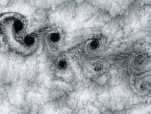Peculiarities of Design Parameters Definition of Wind Load on Tall Buildings and Complexes

Specialists from “Aluterra SK” Ltd. and production and design department “Epsilon” (scientific maintenance of projects) have accumulated a big practical experience in the field of design and erection of curtain wall facade systems. The article describes peculiarities of definition of wind load design parameters for tall buildings and complexes.
General provisions
When you design, erect and operate tall buildings and complexes, very often you discover that construction norms and rules (SNiPs) being in force don’t have recommendations for aerodynamic coefficients for structures with original shapes and large size, including a majority of tall buildings. Domestic norms of 40s years of the last century prescribed a unique wind load of 40 km/m2 for the whole territory of USSR (excluding littoral and mountain regions).
A wind load determination method being now in force was developed at the beginning of 70s in V.A. Kucherenko Central Scientific Research Institute for Building Structures, underlain by Davenport’s works (1962-1967) and was realized in the SNiP 2.01.07-85* “Loads and actions”. In 1978 the “Instruction book about definition of wind load on buildings and structures”, prepared by M.F. Barshtain was issued. The manual “Dynamic analysis of buildings and structures” edited by B.G. Korenev was published in 1984. When the SNiP 2.01.07-85* “Loads and action” was being prepared, expressions describing a dynamic reaction of structures under a wind action were reduced to a coefficient system and it very simplified a calculation of real interaction between building and wind flow.
The wind load calculation method didn’t have important changes in a new edition of the SP 20.13330.2011. The document doesn’t have principal differences in contrast to the previous SNiP in spite of a number of diagrams and provisions of Eurocode. It should be mentioned that new Ukrainian building norms were drastically edited and it resulted in a considerable increment of design loads. Besides a proximity of applied dynamic approaches, it should be noted that both SNiPs and regional normative documents don’t consider alternatives of tall building location in development and their interference.
A wind speed increment due to influence of neighbouring buildings and site landform aren’t taken into consideration. (Norms ASCE 7-05 being in force in USA take into consideration the fact by raising coefficients 1.8 - 2.0). An aerodynamic load dispatch in SNiP (SP) requires an amendment too. An aerodynamic coefficient on windward surface of detached tall building is determined as a value is constant along the height and doesn’t depend on stiff characteristics of the building.
A pressure range offered by Davenport describes only a loading for a windward side of building. A wind flow turbulence along the height observed almost in all measurements on location isn’t taken into account. Loading peculiarities for roofs and coverings with parapets and abatjours aren’t determined. Also it necessary to specify a location and sizes of zones where there are increased local wind pressures. Established approaches were suitable for low and medium buildings in sparse site development.
Tall buildings (particularly, rather compact complexes in relatively dense developments) need more accurate methods. Air layers of a thickness of 100 - 300 m were discovered in surface layer at a height higher than 200 m and they can be at any height under the ground and have a high speed. Unfortunately, investigations of similar meteorological phenomena aren’t carried out on a regular basis and there aren’t statistics are necessary for practical application. The SNiP doesn’t have (or it isn’t in full) a standardization method for peak (maximal in intensity) wind load values which are to be taken into account when envelopes and elements of fixation are being designed.
Full version you can download here
 Text by VIKTOR RAZUVAEV , manager of “Aluterra SK” Ltd., ANTON SUTIAGIN, technical director of production and design department “Epsilon”
Text by VIKTOR RAZUVAEV , manager of “Aluterra SK” Ltd., ANTON SUTIAGIN, technical director of production and design department “Epsilon”


